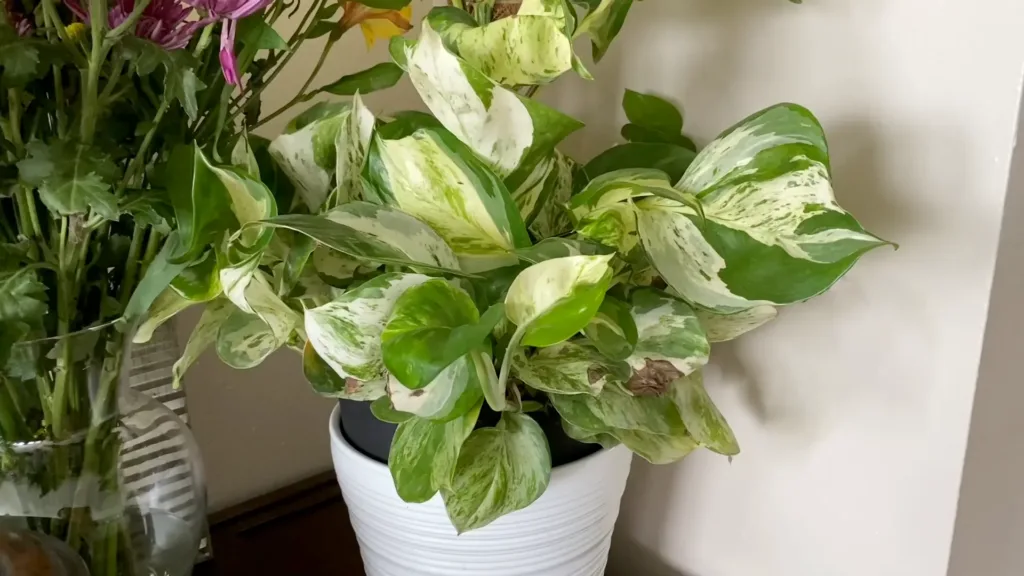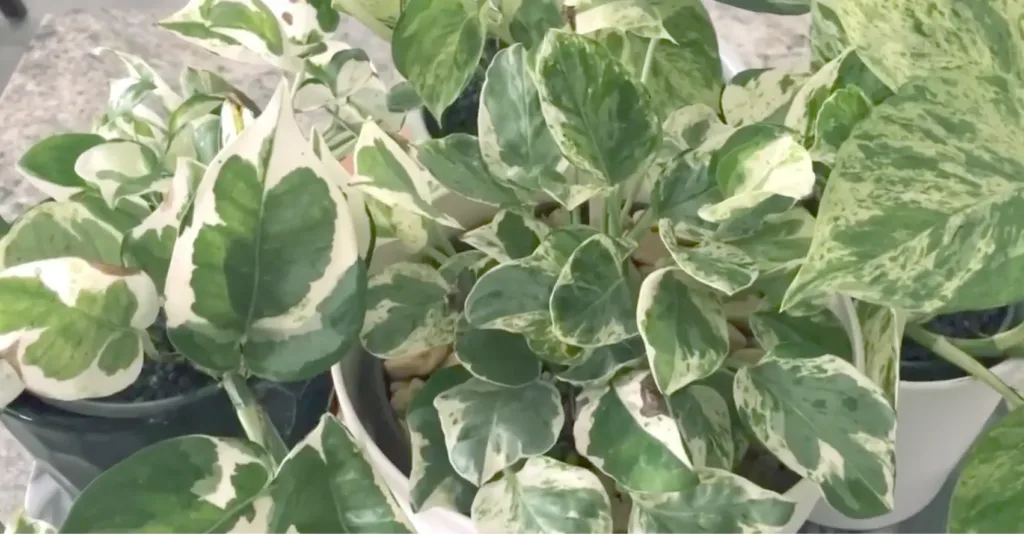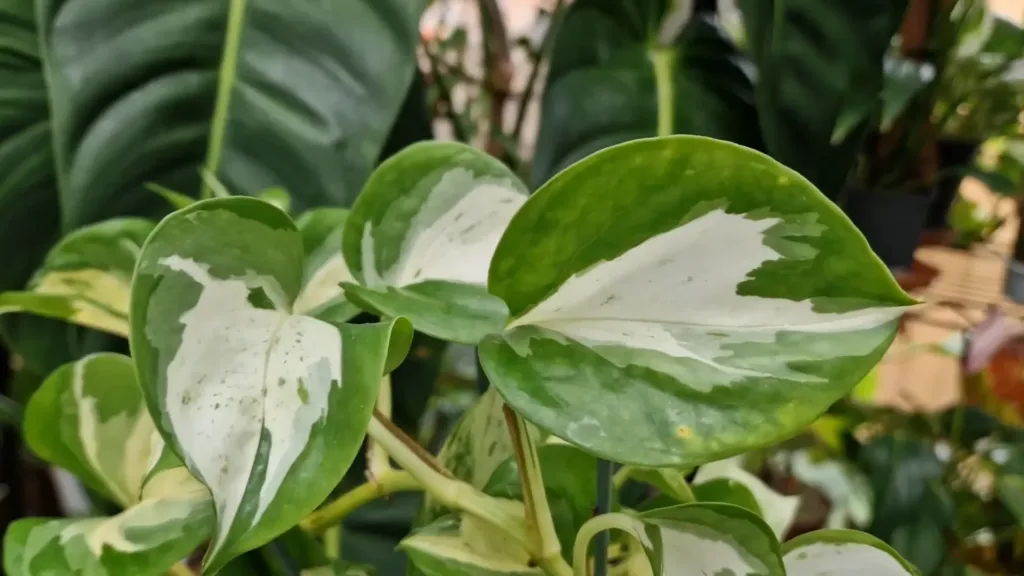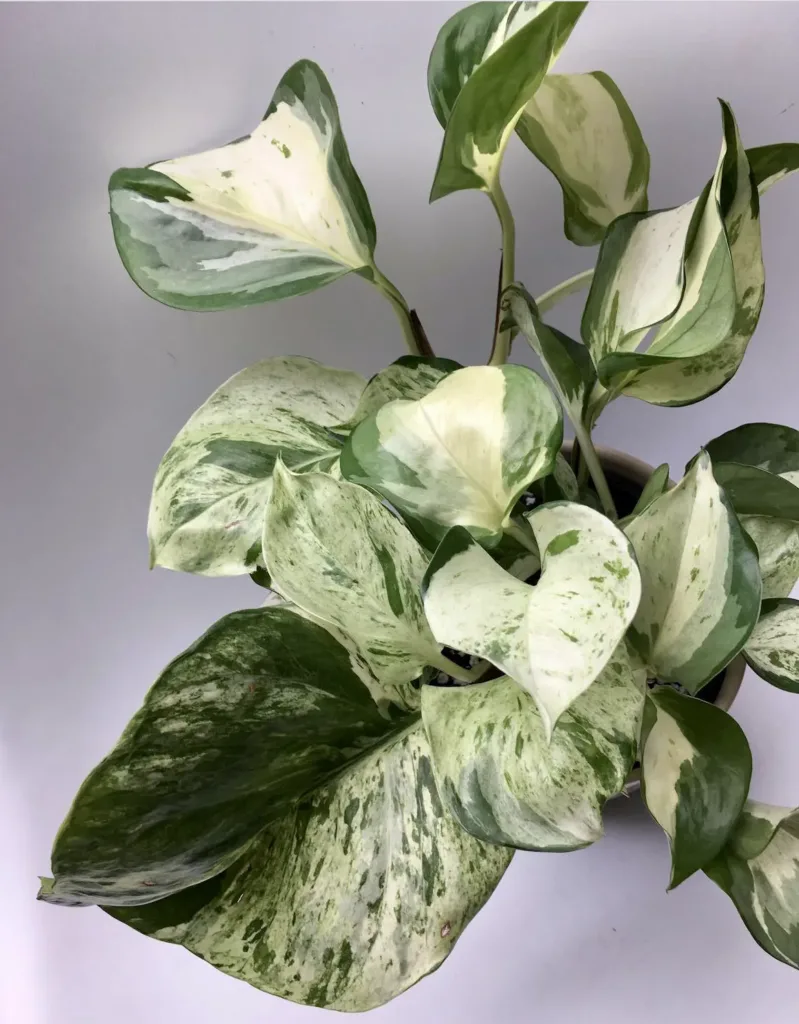Caring for Manjula Pothos? Ensure lush growth with our direct, to-the-point guide. From optimal lighting to precise watering, we’ve got you covered. As a tropical plant, Manjula Pothos has specific needs that stem from its natural habitat, setting the stage for its care requirements discussed throughout this guide. Get ready to learn straightforward and effective care tips that will keep your Manjula Pothos flourishing.
Table of Contents
Quick Tips
- Manjula Pothos is a stunning plant with variegated heart-shaped leaves and dense foliage, needing bright indirect light and careful watering to prevent root rot and maintain its unique look.
- Balanced watering and humidity are key to this plant’s health—allow topsoil to dry between waterings and aim for 50-60% humidity, especially after pruning or during propagation.
- Propagate through stem cuttings for fuller growth, prune during growth seasons for shape, and monitor for common pests like mealybugs and diseases like root rot for long-term vitality.
The Beauty of Manjula Pothos

When it comes to houseplants, the Manjula Pothos is in a league of its own, just like the Marble Queen Pothos. This living piece of art is a testament to nature’s creativity, with its wide, heart-shaped leaves that display a unique mix of variegated shades of:
- silver
- white
- cream
- light green
This stunning variegation is one of the reasons why so many plant enthusiasts are drawn to the epipremnum aureum, also known as the jade pothos, a particular variety of this pothos. With numerous pothos varieties available, the jade pothos stands out due to its unique appearance.
But the beauty of the Manjula Pothos goes beyond its colors. The plant’s variegation is unique to each leaf, with many leaves showing a harmonious mix of large green patches amidst the variegated areas. This creates a beautifully textured appearance, adding another layer of visual interest to the plant.
Yet, the Manjula Pothos is not just about its leaves. Its dense foliage contributes significantly to its attractiveness, providing a lush, tropical ambiance to any space it occupies. Whether you’re looking to liven up your living room or add a touch of green to your office, the Manjula Pothos is a reliable choice that never fails to impress.
Variegated Leaves
The variegated leaves of the Manjula Pothos are its signature feature, setting it apart from other pothos plants. The white, green, and cream variegation on its large, heart-shaped leaves gives the plant its distinctive look. This unique pattern is not just beautiful; it’s also a testament to nature’s creativity and diversity.
The variegation patterns on Manjula Pothos leaves are often heavily flecked and splashed, adding to the plant’s overall dense and textured foliage. Each leaf is like a unique piece of art, showcasing a harmonious mix of large green patches amidst the variegated areas. This delicate balance of colors and patterns makes each leaf, and indeed the entire plant, a sight to behold.
Dense Foliage

In addition to its variegated leaves, the happy leaf pothos, also known as the manjula pothos plant, features dense foliage that stands out. This lush, tropical greenery brings an air of abundance and vitality, bringing a warm and welcoming atmosphere to any space.
Whether it’s perched on a bookshelf, hanging in a basket, or climbing a moss pole, the Manjula Pothos’ dense foliage makes it a visually appealing addition to any indoor setting.
Ideal Lighting Conditions for Manjula Pothos
Like other houseplants, the Manjula Pothos flourishes under particular light conditions. Supplying the right intensity and type of light can help sustain its vibrant variegation and foster healthy growth. Don’t worry, determining the perfect lighting conditions is simpler than you may think.
The key is to provide bright indirect light, as this is crucial for maintaining the distinctive variegation and vibrant foliage of the Manjula Pothos. However, it’s important to avoid intense, direct sunlight, which can scorch the leaves and lead to a loss of variegation in new leaves.
Although the Manjula Pothos can adapt to lower light conditions, insufficient lighting may reduce the variegation, leading to greener foliage. So, it’s always a good idea to monitor your plant and adjust its position accordingly to ensure it gets enough light without getting scorched.
Bright Indirect Light
So, what exactly does ‘bright indirect light’ mean? Well, it’s the kind of light you’d get from a north-facing window or a spot that’s shielded from the sun’s intense rays by a sheer curtain or some foliage. This kind of light is essential for the Manjula Pothos to maintain its distinctive variegated foliage and promote healthy growth.
Direct sunlight can damage the delicate leaves of the Manjula Pothos, leading to fading variegation and potential leaf burn. Therefore, it’s important to find a spot that offers plenty of light, but not the harsh, direct kind.
Rotating the Plant
In addition to providing the right amount and type of light, it’s also important to rotate your Manjula Pothos regularly. This ensures that all parts of the plant get an equal amount of light, promoting even growth and maintaining the distinct variegated foliage.
But why is rotation necessary? Well, plants naturally grow towards the light. So, if one side of your Manjula Pothos is always facing the light source, it may grow lopsided or ‘leggy’ as it reaches for the light. Regular rotation ensures that each side of the plant receives adequate light, maintaining a balanced shape and preventing the plant from becoming leggy.
Soil Preferences and Drainage
Let’s switch our focus to soil and drainage. The appropriate soil mix and efficient drainage are vital for your Manjula Pothos’ health. Both factors significantly contribute to nutrient provision and prevention of issues like root rot from excess water.
The ideal soil for Manjula Pothos should offer excellent drainage while still retaining adequate water to satisfy its moisture needs. This balance is crucial for preventing overwatering issues, which can lead to root rot. A recommended potting mix consists of loamy and well-drained soil, incorporating elements like peat-free compost, orchid bark, perlite, and horticultural grit, aiming for a neutral pH of 6.1-6.5.
Apart from the soil mix, it’s also important to consider the drainage capabilities of your pot. Pots with a drainage hole are advised to allow excess water to escape and ensure that the roots remain healthy. This way, your Manjula Pothos will have the best possible growing conditions.
Well-Draining Soil
Regarding your Manjula Pothos’ health, the significance of well-draining soil should never be overlooked. Such soil type not only prevents root rot but also stimulates healthy growth by allowing excess water escape, thus preventing the roots from becoming waterlogged.
A recommended well-draining soil mix for preventing root rot includes components such as coco coir and perlite or vermiculite. This mix is essential for successful soil propagation of Manjula Pothos.
Soil Components
The right soil mix is a blend of several components that work together to provide a well-aerated and nutrient-rich environment for your Manjula Pothos. A potting mix high in components like coco coir, orchid bark, and pumice or vermiculite helps ensure a well-aerated environment that is conducive to the growth of Manjula Pothos.
To prevent soil compaction and maintain proper drainage, materials like perlite or coarse sand can be added to the potting mix. This prevents the root system from becoming waterlogged. You can even create your homemade potting mix using equal parts of peat moss, perlite, and compost to provide a nutrient-rich medium with ample aeration for Manjula Pothos plants.
Watering and Humidity Requirements
Watering and humidity play a significant role in your Manjula Pothos’ health and growth. The plant should not be extremely dry nor overly watered, suggesting a need for balanced watering. Allow the soil to dry out to a depth of 2 to 3 inches between waterings, which can be checked by feeling if the top 1-2 inches of the soil are dry.
Rainwater or filtered water is recommended for watering Manjula Pothos to provide the best care for the plant. In addition to watering, maintaining adequate humidity can also boost the growth of Manjula Pothos, contributing to its overall health and vitality.
Watering Frequency
Finding the right balance in watering frequency is crucial for the health of your Manjula Pothos. If you notice your plant’s leaves wilting or drooping, it’s a clear indication that the plant needs water to thrive. Make sure to give it a good drink to help it recover. However, it’s important not to overwater your plant. The soil should be allowed to dry out between waterings, maintaining a moist soil environment without saturating it. Also, using tepid water is recommended to avoid shock from temperature changes.
If you notice yellow leaves, it might indicate overwatering and root rot; ensure proper drainage and let the soil dry between waterings to prevent this issue.
Humidity Levels
Manjula Pothos thrives in environments with 60-90% relative humidity, although around 50% is generally sufficient to maintain plant health. If you’re unsure about the humidity level in your home, a hygrometer can be a useful tool to monitor the indoor humidity level to ensure it is optimal for Manjula Pothos care.
Increasing humidity can be achieved by using pebble trays with water or humidifiers, and grouping plants together can create a beneficial microclimate with higher humidity. After pruning or during propagation to fuller plants, maintaining humidity levels around 50-60% can be particularly beneficial and may encourage the growth of aerial roots.
Propagation Techniques for Manjula Pothos

The ability to propagate your plants is a delightful aspect of plant ownership, and Manjula Pothos offers this joy. Propagation not only enables you to expand your plant collection but also fosters plant growth. Whether a seasoned plant parent or a newcomer, propagating Manjula Pothos can bring a rewarding experience.
Manjula Pothos can be propagated via stem cutting by following these steps:
- Snip beneath the root node of the plant.
- Place the cutting in water or soil until roots form.
- Once the cuttings have rooted, repot them back into the original pot.
- This will lead to a fuller, bushier Manjula Pothos.
- Generally, roots typically develop from propagated stem cuttings of Manjula Pothos in less than one month.
Stem Cuttings
When it comes to propagation, stem cuttings are the way to go. Here’s how to propagate Manjula Pothos using stem cuttings:
- Select healthy stem cuttings that have at least one node and preferably plump aerial roots.
- Submerge the node of the selected cutting in water, ensuring that leaves remain above the water surface to avoid rot.
- Wait until roots are 3-5 cm with side shoots.
- Transfer the cutting to soil.
For soil propagation, follow these steps:
- Insert the cuttings about 2 inches deep into well-draining soil, allowing space for growth.
- Once cuttings are rooted, provide them with bright, indirect light.
- Maintain a consistent room temperature to foster growth.
Encouraging Fuller Growth
After propagation, it’s all about encouraging fuller growth in your Manjula Pothos. Using a lighter soil mix for young Manjula Pothos cuttings and incorporating more compost as the plant matures encourages healthier and fuller growth. When new leaf growth appears on the Manjula Pothos cuttings, it indicates successful soil rooting which is crucial for achieving a fuller look.
After propagation, it’s best to delay fertilizing Manjula Pothos cuttings; start with a half-strength fertilizer only a few weeks later to support fuller growth without risking damage. This way, your Manjula Pothos will grow to be lush and full, a testament to your excellent care and attention.
Pruning and Maintenance
A well-pruned Manjula Pothos is a visual treat. Regular pruning is vital as it spurs new growth and maintains the plant’s fullness, enhancing its health and visual appeal. Pruning also promotes better air circulation around the leaves, helping prevent pest infestations by creating an unfavorable environment for pests.
After pruning, Manjula Pothos should be:
- Watered to help reduce stress and promote recovery
- Kept in bright, indirect light
- Maintained at a consistent temperature between 65-85°F (18-29°C) to support optimal regrowth.
When to Prune
Timing is everything when it comes to pruning your Manjula Pothos. The optimal period to prune this plant is during spring or early summer. This time is considered the best for pruning as Manjula Pothos is naturally in a growth phase during this period, allowing it to recover quickly and flourish.
Pruning Techniques
While pruning your Manjula Pothos, ensure to use clean, sharp scissors or pruning shears and make angled cuts just above a leaf node, ideally at a 45-degree angle. This not only promotes new growth but also minimizes the risk of damaging the plant.
When pruning, always remember that less is more. Be careful not to remove more than one-third of the Manjula Pothos to prevent over-pruning and to preserve the health and stability of the plant. This way, your Manjula Pothos will remain vibrant and lush, adding a touch of greenery to your space for a long time.
Common Pests and Diseases

Like other houseplants, Manjula Pothos can occasionally suffer from pests and diseases. Common pests that may trouble this plant include:
- Mealybugs
- Scale
- Fungus gnats
- Spider mites
It’s worth noting that while dealing with these pests, you should be aware of the fact that Manjula Pothos toxic components can be harmful if ingested.
But, there’s no need for alarm! Utilizing the right strategies can help prevent these pests and maintain your Manjula Pothos’ health.
The most common of plant diseases in Manjula Pothos is Phytophthora root rot, which is often related to excessive moisture conditions. Signs of this disease include brown leaves, wilting stems, and overall withering of the plant. But don’t worry! With the right care and maintenance, you can easily prevent and treat this disease.
Pest Prevention
Prevention is always better than cure, especially when it comes to pest infestations. Here are some tips to prevent and control common pests:
- Regular cleaning of leaves and maintaining a mite-deterring environment, such as high humidity, can prevent spider mite infestations.
- Sticky traps can effectively control fungus gnat populations.
- Soil treatments containing Bacillus thuringiensis subsp. israelensis can also help control fungus gnats.
By following these preventive measures, you can keep your plants healthy and pest-free.
To prevent scale insects, monitor new plants for any signs of infestation and treat existing plants with horticultural oil or neem oil. A strong water spray can dislodge aphids from the plant, and introducing beneficial insects like lacewings can help control aphid populations naturally.
Mealybug prevention includes isolating infested plants, regular checks for pests, and application of neem oil or insecticidal soap as a preventive spray. General pest prevention strategies involve quarantining new plants, using sterile potting mix, inspecting plants regularly, and ensuring good air circulation.
Disease Management
Managing diseases in Manjula Pothos is all about early detection and prompt action. Black or dark brown leaves are a key identifier of Phytophthora root rot, a severe plant disease. Yellow leaves can be symptomatic of either disease, root rot issues, or insufficient lighting conditions.
Disease or root rot in Manjula Pothos can be due to factors such as overwatering, poor drainage, or the presence of pathogens in the soil. By monitoring your plant regularly and providing the right care, you can prevent most diseases and keep your Manjula Pothos healthy.
Toxicity of Manjula Pothos
Caring for Manjula Pothos is pleasurable, yet it’s crucial to be aware that the plant is toxic to humans and pets. This is caused by its calcium oxalate crystals content, leading to irritation and vomiting upon ingestion. In dogs, ingestion symptoms may include:
- a burning mouth sensation
- excessive drooling
- gastrointestinal upset
- potential oral tissue swelling
While ingestion of Manjula Pothos can potentially lead to kidney damage or urinary blockages, most dogs will recover well with timely veterinary treatment and follow-up care. To keep pets safe, it’s recommended to:
- Train them to avoid the plant
- Supervise them closely
- Keep Manjula Pothos out of reach
- Consider pet-safe plant alternatives like spider plants, African violets, or certain succulents.
Troubleshooting Manjula Pothos Problems
Despite your best efforts, you might come across some issues while caring for your Manjula Pothos. Here are some common problems and their potential causes:
- Yellow leaves may result from either overwatering or too much direct sunlight. It’s important to monitor the plant’s environmental conditions to determine the cause of the discoloration and make necessary adjustments.
- Brown leaves or spots can signal under-watering or low humidity.
- Leaf curling can result from inconsistent watering, excessive light, improper temperatures, or pest issues.
Optimal soil moisture, diffused lighting, stable temperature, and pest control can help remedy and prevent leaf curling. Proactive measures including consistent watering, humidity maintenance, and regular leaf inspections can sustain Manjula Pothos health and avert leaf curling. A lackluster appearance or drooping leaves are visual cues that Manjula Pothos requires watering.
To ensure healthy Manjula Pothos plants, implement air circulation strategies, and regularly inspect for pests to act promptly when issues are detected.
Final Thoughts
From its unique variegated leaves to its lush, dense foliage, the Manjula Pothos is a true gem among houseplants. Its beauty, combined with its relatively easy care requirements, makes it a popular choice for both novice and experienced plant enthusiasts. By providing the right lighting conditions, good soil with proper drainage, adequate watering, and humidity, you can keep your Manjula Pothos flourishing and looking its best.
Remember, a healthy Manjula Pothos is a product of consistent care and attention. Regular pruning, pest prevention, proper propagation techniques, and timely intervention in case of diseases can all contribute to the overall health and vitality of your plant. With the right care, your Manjula Pothos will continue to add beauty and a touch of nature to your space for years to come.
Answers to Common Queries
What is the ideal light condition for Manjula Pothos?
The ideal light condition for Manjula Pothos is bright indirect light, and it should be kept away from intense, direct sunlight to avoid scorching the leaves and loss of variegation.
How often should Manjula Pothos be watered?
Water your Manjula Pothos only when the soil has dried out to prevent overwatering and root rot. It’s important to allow the soil to dry out between waterings while keeping it moist – typically every 1-2 weeks.
How can I propagate Manjula Pothos?
You can propagate Manjula Pothos by taking a stem cutting, snipping beneath the root node, and then placing it in water or soil until roots form. It’s a simple process and can be done easily at home.
How can I prevent pest infestations in Manjula Pothos?
To prevent pest infestations in your Manjula Pothos, make sure to regularly clean the leaves, maintain high humidity, and inspect the plant for any signs of pests. You can also use neem oil or insecticidal soap as a preventive spray to keep pests at bay.
Is Manjula Pothos toxic?
Yes, Manjula Pothos is toxic to humans and pets due to the content of calcium oxalate crystals, which can cause irritation and vomiting if ingested. Keep the plant out of reach of pets and children.

Leave a Comment